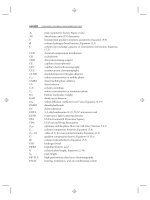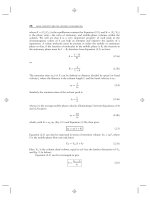Introduction to Modern Liquid Chromatography, Third Edition part 3 ppsx
Bạn đang xem bản rút gọn của tài liệu. Xem và tải ngay bản đầy đủ của tài liệu tại đây (50.49 KB, 10 trang )
xviii CONTENTS
11.2.5.2 Lower Limit of Quantification
(LLOQ or LOQ), 514
11.2.5.3 Upper Limits, 515
11.2.5.4 Samples Outside Limits, 515
11.3 Qualitative Analysis, 516
11.3.1 Retention Time, 516
11.3.2 On-line Qualitative Analysis, 517
11.3.2.1 UV Detection, 518
11.3.2.2 LC-MS, 518
11.3.2.3 LC-FTIR, 519
11.3.2.4 LC-NMR, 519
11.3.2.5 Chemiluminescence Nitrogen
Detector (CLND), 519
11.3.2.6 Laser Light-Scattering Detector
(LLSD), 519
11.3.2.7 Chiral Detectors, 519
11.3.2.8 Off-line Analysis, 519
11.4 Quantitative Analysis, 520
11.4.1 Calibration, 520
11.4.1.1 External Standardization, 520
11.4.1.2 Internal Standardization, 523
11.4.1.3 Area Normalization, 525
11.4.1.4 Standard Addition, 526
11.4.1.5 Evaluating Calibration
Curves, 527
11.4.2 Trace Analysis, 529
11.5 Summary, 529
References, 529
12 METHOD VALIDATION 531
with Michael Swartz
12.1 Introduction, 532
12.2 Terms and Definitions, 534
12.2.1 Accuracy, 535
12.2.2 Precision, 536
12.2.2.1 Repeatability, 536
12.2.2.2 Intermediate Precision, 537
12.2.2.3 Reproducibility, 537
12.2.2.4 Ruggedness, 538
12.2.3 Specificity, 539
12.2.4 Limit of Detection and Limit of
Quantification, 539
12.2.5 Linearity and Range, 540
12.2.6 Robustness, 540
CONTENTS xix
12.3 System Suitability, 542
12.4 Documentation, 543
12.4.1 Validation Protocol, 544
12.4.2 Test Method, 544
12.4.3 Validation Report, 545
12.5 Validation for Different Pharmaceutical-Method
Types, 546
12.5.1 Category 1 Methods, 546
12.5.2 Category 2 Methods, 547
12.5.3 Category 3 Methods, 547
12.5.4 Category 4 Methods, 548
12.6 Bioanalytical Methods, 548
12.6.1 Reference Standard Preparation, 549
12.6.2 Bioanalytical Method Development and
Validation, 549
12.6.2.1 Selectivity, 550
12.6.2.2 Accuracy, Precision, and
Recovery, 550
12.6.2.3 Calibration/Standard Curve, 551
12.6.2.4 Bioanalytical Sample
Stability, 551
12.6.3 Routine Application of the Bioanalytical
Method, 552
12.6.4 Bioanalytical Method Documentation, 553
12.7 Analytical Method Transfer (AMT), 554
12.7.1 Analytical Method-Transfer Options, 555
12.7.1.1 Comparative Testing, 555
12.7.1.2 Co-validation between
Laboratories, 556
12.7.1.3 Method Validation and/or
Revalidation, 556
12.7.1.4 Transfer Waiver, 556
12.7.2 Essentials of AMT, 556
12.7.2.1 Pre-approved Test Plan
Protocol, 557
12.7.2.2 Description of Method/Test
Procedures, 557
12.7.2.3 Description and Rationale of Test
Requirements, 557
12.7.2.4 Acceptance Criteria, 557
12.7.2.5 Documentation of Results, 558
12.7.3 Potential AMT Pitfalls, 558
12.7.3.1 Instrument Considerations, 558
12.7.3.2 HPLC Columns, 558
xx CONTENTS
12.7.3.3 Operator Training, 561
12.8 Method Adjustment or Method Modification, 561
12.8.1 pH Adjustments, 563
12.8.2 Concentration of Buffer Salts, 563
12.8.3 Ratio of Components in the Mobile
Phase, 563
12.8.4 Wavelength of the UV-Visible Detector, 564
12.8.5 Temperature Adjustments, 564
12.8.6 Column Length, Diameter, and Particle-Size
Adjustments, 564
12.9 Quality Control and Quality Assurance, 564
12.9.1 Quality Control, 565
12.9.2 Quality Assurance, 565
12.10 Summary, 565
References, 566
13 BIOCHEMICAL AND SYNTHETIC POLYMER SEPARATIONS 569
with Timothy Wehr, Carl Scandella, and Peter Schoenmakers
13.1 Biomacromolecules, 570
13.2 Molecular Structure and Conformation, 571
13.2.1 Peptides and Proteins (Polypeptides), 571
13.2.1.1 Primary Sequence, 571
13.2.1.2 Secondary Structure, 573
13.2.1.3 Tertiary and Quaternary
Structure, 574
13.2.1.4 Post-translational
Modifications, 574
13.2.2 Nucleic Acids, 574
13.2.2.1 Single-Stranded Nucleic
Acids, 574
13.2.2.2 Double-Stranded Nucleic
Acids, 575
13.2.3 Carbohydrates, 576
13.2.4 Viruses, 578
13.3 Special Considerations for Biomolecule HPLC, 579
13.3.1 Column Characteristics, 579
13.3.1.1 Pore Size, 579
13.3.1.2 Particle Size, 581
13.3.1.3 Support Characteristics and
Stability, 582
13.3.1.4 Recovery of Mass and Biological
Activity, 583
13.3.2 Role of Protein Structure in
Chromatographic Behavior, 583
CONTENTS xxi
13.4 Separation of Peptides and Proteins, 584
13.4.1 Reversed-Phase Chromatography
(RPC), 584
13.4.1.1 Column Selection, 585
13.4.1.2 Mobile-Phase Selection, 585
13.4.1.3 Temperature, 588
13.4.1.4 Gradient Elution, 589
13.4.1.5 Effect of Polypeptide
Conformation, 593
13.4.1.6 Capillary Columns and Nanospray
Ionization Sources, 595
13.4.1.7 RPC Method Development, 595
13.4.2 Ion-Exchange Chromatography (IEC) and
Related Techniques, 597
13.4.2.1 Column Selection, 599
13.4.2.2 Mobile-Phase Selection, 601
13.4.2.3 Chromatofocusing, 603
13.4.2.4 Hydroxyapatite
Chromatography, 604
13.4.2.5 Immobilized-Metal Affinity
Chromatography (IMAC), 605
13.4.3 Hydrophobic Interaction Chromatography
(HIC), 608
13.4.3.1 Supports and Ligands for
HIC, 609
13.4.3.2 Other Conditions, 610
13.4.4 Hydrophilic Interaction Chromatography
(HILIC), 613
13.4.4.1 Stationary Phases for HILIC, 613
13.4.4.2 Mobile Phases for HILIC, 614
13.4.4.3 Application of HILIC to Peptides
and Proteins, 614
13.4.4.4 Electrostatic-Repulsion
Hydrophilic-Interaction
Chromatography (ERLIC), 614
13.4.5 Multidimensional Liquid Chromatography
(MDLC) in Proteomics, 616
13.4.5.1 Use with Fraction Collection, 617
13.4.5.2 Directly Coupled MDLC, 617
13.4.5.3 MDLC with Column
Switching, 618
13.5 Separation of Nucleic Acids, 618
13.5.1 Anion-Exchange Chromatography, 619
13.5.2 Reversed-Phase Chromatography, 620
xxii CONTENTS
13.5.2.1 Oligonucleotides, 621
13.5.2.2 Restriction Fragments and PCR
Products, 621
13.5.2.3 Denaturing HPLC, 621
13.5.2.4 RPC-
5
Chromatography, 623
13.5.3 Hydrophobic Interaction
Chromatography, 624
13.6 Separation of Carbohydrates, 625
13.6.1 Hydrophilic Interaction
Chromatography, 625
13.6.2 Ion-Moderated Partition
Chromatography, 626
13.6.3 High-Performance Anion-Exchange
Chromatography, 628
13.7 Separation of Viruses, 630
13.8 Size-Exclusion Chromatography (SEC), 631
13.8.1 SEC Retention Process, 632
13.8.2 Columns for Gel Filtration, 633
13.8.2.1 Support Materials, 634
13.8.2.2 Pore Size and Porosity, 635
13.8.2.3 Particle Diameter, 636
13.8.2.4 Increasing Resolution, 636
13.8.3 Mobile Phases for Gel Filtration, 636
13.8.4 Operational Considerations, 637
13.8.4.1 Column Capacity, 637
13.8.4.2 Use of Denaturing
Conditions, 637
13.8.4.3 Column Calibration, 638
13.8.4.4 Exploiting Non-ideal
Interactions, 638
13.8.5 Advantages and Limitations of SEC, 638
13.8.6 Applications of SEC, 639
13.8.6.1 Analytical Applications, 639
13.8.6.2 Preparative Applications, 641
13.9 Large-Scale Purification of Large Biomolecules, 641
13.9.1 Background, 641
13.9.2 Production-Scale Purification of
rh-Insulin, 642
13.9.2.1 Purification Targets, 643
13.9.2.2 Stationary Phases, 643
13.9.2.3 Packing the Column, 643
13.9.2.4 Stability of the Product and
Column, 643
13.9.2.5 Mobile-Phase Composition, 644
CONTENTS xxiii
13.9.2.6 Separation, 645
13.9.2.7 Column Regeneration, 645
13.9.2.8 Small-Scale Purification, 645
13.9.2.9 Scale-Up, 646
13.9.2.10 Production-Scale
Purification, 647
13.9.3 General Requirements for Prep-LC
Separations of Proteins, 648
13.10 Synthetic Polymers, 648
13.10.1 Background, 648
13.10.2 Techniques for Polymer Analysis, 651
13.10.3 Liquid-Chromatography Modes for Polymer
Analysis, 653
13.10.3.1 Size-Exclusion
Chromatography, 653
13.10.3.2 Interactive Liquid
Chromatography, 653
13.10.3.3 Liquid Chromatography under
Critical Conditions, 655
13.10.3.4 Other Techniques, 655
13.10.3.5 Chemical Composition as a
Function of Molecular Size, 656
13.10.4 Polymer Separations by Two-Dimensional
Chromatography, 657
References, 658
14 ENANTIOMER SEPARATIONS 665
with Michael L
¨
ammerhofer, Norbert M. Maier and Wolfgang
Lindner
14.1 Introduction, 666
14.2 Background and Definitions, 666
14.2.1 Isomerism and Chirality, 667
14.2.2 Chiral Recognition and Enantiomer
Separation, 669
14.3 Indirect Method, 670
14.4 Direct Method, 675
14.4.1 Chiral Mobile-Phase-Additive Mode
(CMPA), 675
14.4.2 Chiral Stationary-Phase Mode (CSP), 677
14.4.3 Principles of Chiral Recognition, 679
14.4.3.1 ‘‘Three-Point Interaction
Model’’, 679
14.4.3.2 Mobile-Phase Effects, 680
14.5 Peak Dispersion and Tailing, 681
xxiv CONTENTS
14.6 Chiral Stationary Phases and Their Characteristics, 681
14.6.1 Polysaccharide-Based CSPs, 682
14.6.2 Synthetic-Polymer CSPs, 689
14.6.3 Protein Phases, 691
14.6.4 Cyclodextrin-Based CSPs, 697
14.6.5 Macrocyclic Antibiotic CSPs, 699
14.6.6 Chiral Crown-Ether CSPs, 706
14.6.7 Donor-Acceptor Phases, 707
14.6.8 Chiral Ion-Exchangers, 711
14.6.9 Chiral Ligand-Exchange CSPs (CLEC), 713
14.7 Thermodynamic Considerations, 715
14.7.1 Thermodynamics of Solute-Selector
Association, 715
14.7.2 Thermodynamics of Direct Chromatographic
Enantiomer Separation, 716
14.7.3 Site-Selective Thermodynamics, 717
References, 718
15 PREPARATIVE SEPARATIONS 725
with Geoff Cox 725
15.1 Introduction, 726
15.1.1 Column Overload and Its
Consequences, 726
15.1.2 Separation Scale, 727
15.1.2.1 Larger Diameter Columns, 728
15.1.2.2 Optimized Conditions for
Prep-LC, 728
15.1.2.3 Other Considerations, 728
15.2 Equipment for Prep-LC Separation, 730
15.2.1 Columns, 730
15.2.2 Sample Introduction, 731
15.2.2.1 Loop Injectors, 731
15.2.2.2 Pump Injection, 732
15.2.3 Detectors, 733
15.2.3.1 UV Detectors, 733
15.2.3.2 Other Detectors, 734
15.2.4 Fraction Collection, 734
15.2.5 Product Recovery (Removal of the Mobile
Phase), 735
15.3 Isocratic Elution, 736
15.3.1 Sample-Weight and Separation, 736
15.3.1.1 Sorption Isotherms, 737
15.3.1.2 Peak Width for Small versus
Large Samples, 738
CONTENTS xxv
15.3.2 Touching-Peak Separation, 739
15.3.2.1 Column Saturation Capacity, 740
15.3.2.2 Sample-Volume Overload, 742
15.3.2.3 Sample Solubility, 742
15.3.2.4 Method Development, 745
15.3.2.5 Fraction Collection, 747
15.4 Severely Overloaded Separation, 748
15.4.1 Recovery versus Purity, 748
15.4.2 Method Development, 749
15.4.2.1 Column Efficiency, 750
15.4.2.2 ‘‘Crossing Isotherms’’, 750
15.5 Gradient Elution, 751
15.5.1 Isocratic and Gradient Prep-LC
Compared, 752
15.5.2 Method Development for Gradient
Prep-LC, 753
15.6 Production-Scale Separation, 754
References, 755
16 SAMPLE PREPARATION 757
with Ronald Majors 757
16.1 Introduction, 758
16.2 Types of Samples, 759
16.3 Preliminary Processing of Solid and Semi-Solid
Samples, 760
16.3.1 Sample Particle-Size Reduction, 760
16.3.2 Sample Drying, 762
16.3.3 Filtration, 763
16.4 Sample Preparation for Liquid Samples, 764
16.5 Liquid–Liquid Extraction, 764
16.5.1 Theory, 766
16.5.2 Practice, 766
16.5.3 Problems, 768
16.5.3.1 Emulsion Formation, 769
16.5.3.2 Analyte Adsorption, 769
16.5.3.3 Solute Binding, 769
16.5.3.4 Mutual Phase-Solubility, 769
16.5.4 Special Approaches to Liquid–Liquid
Extraction, 770
16.5.4.1 Microextraction, 770
16.5.4.2 Single-Drop Microextraction,
(SDME), 770
16.5.4.3 Solid-Supported Liquid–Liquid
Extraction (SLE), 770
xxvi CONTENTS
16.5.4.4 ImmobilizedLiquidExtraction
(ILE), 770
16.6 Solid-Phase Extraction (SPE), 771
16.6.1 SPE and HPLC Compared, 772
16.6.2 Uses of SPE, 772
16.6.2.1 Interference Removal, 772
16.6.2.2 Analyte Enrichment, 773
16.6.2.3 Desalting, 774
16.6.2.4 Other Applications, 774
16.6.3 SPE Devices, 774
16.6.3.1 Cartridges, 774
16.6.3.2 Disks, 775
16.6.3.3 Other SPE Formats, 775
16.6.4 SPE Apparatus, 777
16.6.5 SPE Method Development, 778
16.6.5.1 SPE Steps, 779
16.6.5.2 SPE Packings, 781
16.6.6 Example of SPE Method Development:
Isolation of Albuterol from Human
Plasma, 784
16.6.7 Special Topics in SPE, 785
16.6.7.1 Multimodal and Mixed-Phase
Extractions, 785
16.6.7.2 Restricted Access Media
(RAM), 785
16.6.7.3 Molecular-Imprinted Polymers
(MIPs), 787
16.6.7.4 Immunoaffinity Extraction of
Small Molecules, 788
16.6.7.5 QuEChERS and Dispersive
SPE, 789
16.6.7.6 Class-Specific SPE
Cartridges, 789
16.7 Membrane Techniques in Sample Preparation, 790
16.8 Sample Preparation Methods for Solid Samples, 791
16.8.1 Traditional Extraction Methods, 792
16.8.2 Modern Methods for Extracting Solids, 793
16.8.2.1 Modern Soxhlet Extraction, 793
16.8.2.2 Supercritical Fluid Extraction
(SFE), 794
16.8.2.3 Pressurized Fluid-Extraction
(PFE)/Accelerated Solvent
Extraction (ASE), 795
CONTENTS xxvii
16.8.2.4 Microwave-Assisted Solvent
Extraction (MAE), 795
16.9 Column-Switching, 796
16.10 Sample Preparation for Biochromatography, 797
16.11 Sample Preparation for LC-MS, 800
16.12 Derivatization in HPLC, 802
References, 805
17 TROUBLESHOOTING 809
Quick Fix, 809
17.1 Introduction, 810
17.2 Prevention of Problems, 811
17.2.1 System Performance Tests, 811
17.2.1.1 Installation Qualification (IQ),
Operational Qualification (OQ),
and Performance Qualification
(PQ) Tests, 812
17.2.1.2 Gradient Performance Test, 812
17.2.1.3 Additional System Tests, 812
17.2.2 Periodic Maintenance, 812
17.2.3 System-Suitability Testing, 813
17.2.4 Historical Records, 813
17.2.5 Tips and Techniques, 814
17.2.5.1 Removing Air from the
Pump, 814
17.2.5.2 Solvent Siphon Test, 814
17.2.5.3 Pre-mixing to Improve Retention
Reproducibility in Shallow
Gradients, 815
17.2.5.4 Cleaning and Handling Check
Valves, 815
17.2.5.5 Leak Detection, 816
17.2.5.6 Repairing Fitting Leaks, 816
17.2.5.7 Cleaning Glassware, 816
17.2.5.8 For Best Results with TFA, 817
17.2.5.9 Improved Water Purity, 817
17.2.5.10 Isolating Carryover
Problems, 818
17.3 Problem-Isolation Strategies, 819
17.3.1 Divide and Conquer, 819
17.3.2 Easy versus Powerful, 820
17.3.3 Change One Thing at a Time, 820
17.3.4 Address Reproducible Problems, 820









